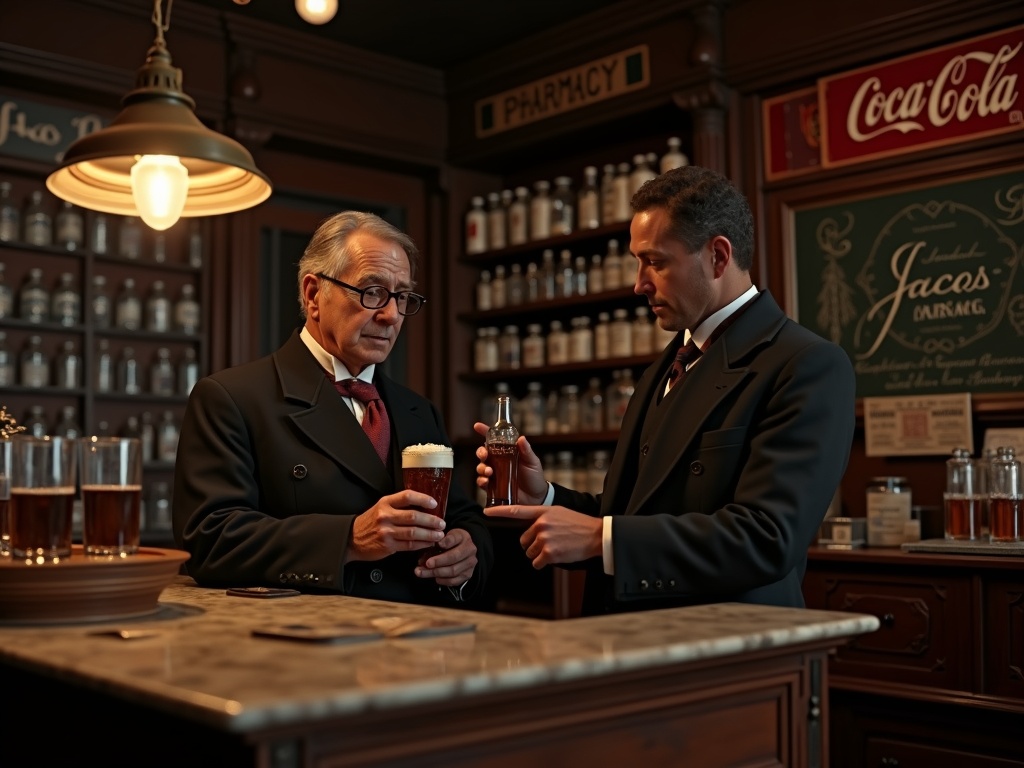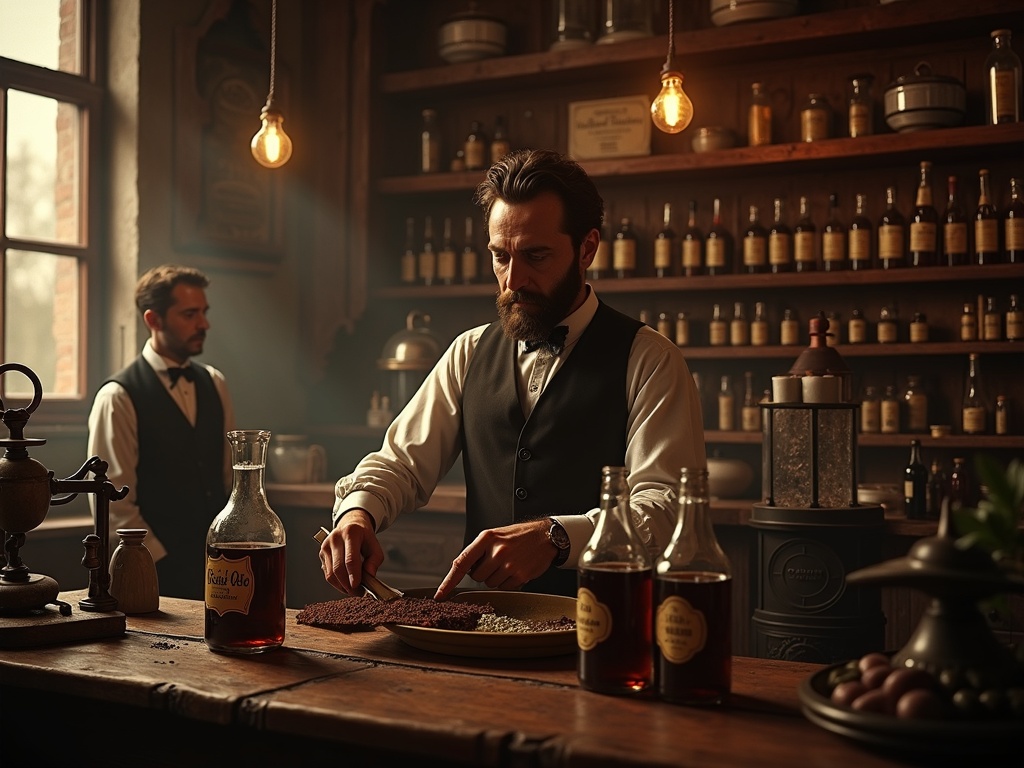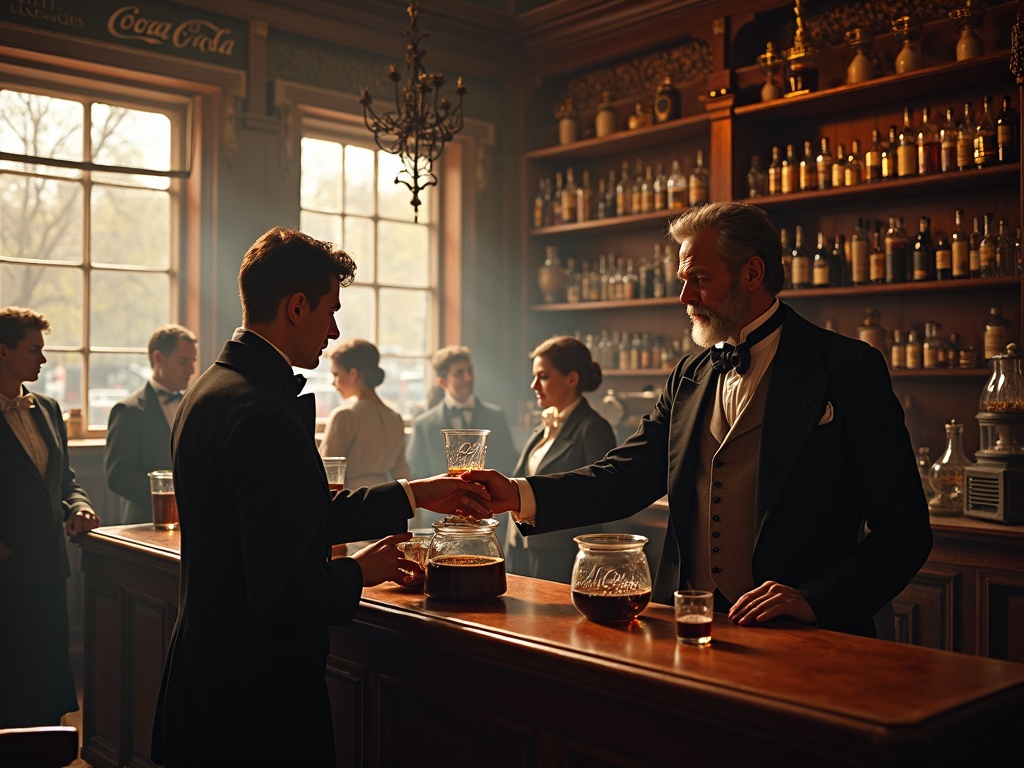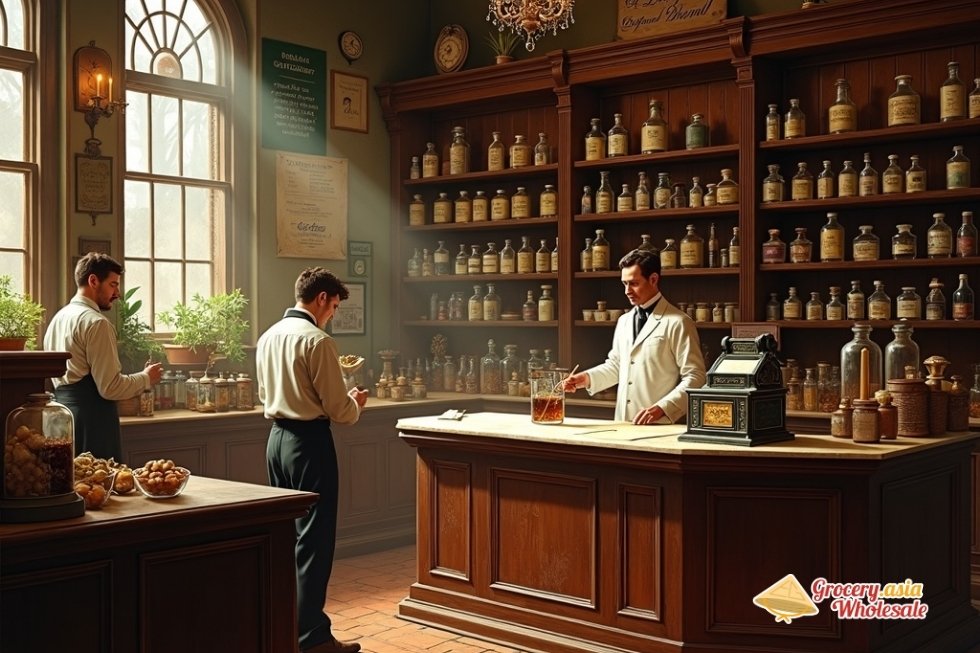No products in the cart.
Beverages News, Coca-Cola Carbonated Soft Drinks, Soft Drinks
When Was Coke Made And Who Created The Recipe
Dr. John Stith Pemberton created Coca-Cola on May 8, 1886. This pharmacist and Civil War veteran from Atlanta, Georgia, developed the iconic beverage as a non-alcoholic alternative to his previous coca wine. Local prohibition laws forced this change. Pemberton first sold his creation at Jacobs’ Pharmacy for five cents a glass. He marketed it as a nerve tonic and brain remedy. This local pharmaceutical product would eventually transform into the globe’s most recognizable soft drink.
Table of Contents
Key Takeaways
- Creation Date and Inventor: Dr. John Stith Pemberton officially created Coca-Cola on May 8, 1886. This pharmacist in Atlanta, Georgia, developed it as a medicinal nerve tonic.
- Original Formula: The initial recipe contained coca leaf extract with trace amounts of cocaine, kola nut extract for caffeine, sugar, carbonated water, and various natural flavoring oils. It was marketed as a therapeutic beverage.
- Business Transformation: Pemberton struggled and died, then Asa Griggs Candler acquired the company for approximately $2,300 in 1891. He transformed it from a failing local business into a national brand through aggressive marketing strategies.
- Formula Evolution: The company completely removed cocaine from the formula by 1904 due to regulatory pressures and health concerns. However, the company still uses decocainized coca leaf extract to maintain the distinctive flavor.
- Branding Legacy: Frank Robinson, Pemberton’s bookkeeper, created both the “Coca-Cola” name and the distinctive Spencerian script logo that remains virtually unchanged today. He established the visual identity that would become globally recognizable.
To learn more about Coca-Cola’s history and branding evolution, you can visit the official Coca-Cola Company website.
When Was Coke Made and Who Created the Recipe
Coca-Cola came into existence on May 8, 1886, in Atlanta, Georgia. Dr. John Stith Pemberton, a pharmacist and Civil War veteran, created this iconic beverage that would eventually become a global phenomenon.
The Birth of an American Icon
Pemberton first sold his creation at Jacobs’ Pharmacy in Atlanta for five cents a glass. The drink emerged from necessity rather than simple innovation. Local prohibition laws forced Pemberton to develop a non-alcoholic alternative to his previous concoction, ‘Pemberton’s French Wine Coca.’
I find it fascinating that Coke’s invention stemmed from personal struggle combined with regulatory pressure. Pemberton intended his new formula to serve as a ‘nerve tonic’ – a healthier alternative to morphine, to which he had become addicted following his Civil War injuries.
The original recipe contained several key ingredients that would define its distinctive taste:
- Coca leaf extract (later removed)
- Kola nut extract for caffeine content
- Sugar for sweetness
- Carbonated water for the signature fizz
- Various natural flavoring oils and acids
Pemberton’s pharmaceutical background proved crucial in developing the syrup’s precise formula. His experience with medicinal compounds allowed him to balance flavors while creating what he marketed as a therapeutic beverage. The drink’s initial positioning as a health tonic reflected the era’s patent medicine culture, where pharmacists regularly sold remedies promising various benefits.
The timing of Coke’s creation coincided perfectly with America’s growing soda fountain culture. Pharmacies across the country featured these establishments, making them ideal distribution points for Pemberton’s new beverage.
Frank Robinson, Pemberton’s bookkeeper and business partner, contributed significantly by naming the drink and creating its distinctive script logo. Robinson believed the two C’s would look appealing in advertising, demonstrating early marketing insight that would prove invaluable.
Despite creating what would become Coca-Cola’s legendary status, Pemberton struggled financially. His addiction and poor health prevented him from fully capitalizing on his invention. He sold portions of his business to various partners, ultimately receiving little financial benefit from his creation.
The original formula underwent modifications almost immediately. Asa Candler, who eventually gained control of the company, refined the recipe and enhanced its marketing. These early adjustments helped establish the foundation for Coca-Cola’s worldwide expansion.
Today’s Coca-Cola maintains the essential character of Pemberton’s 1886 creation, though modern production methods and ingredient sourcing differ significantly from the original pharmacy-based preparation.

From Patent Medicine to Popular Drink: The Original Formula
I find it fascinating that Coca-Cola’s origins lie in patent medicine rather than the refreshing beverage we know today. Dr. John Pemberton’s original 1886 formula contained coca leaf extract with trace amounts of cocaine—approximately 9mg per glass. This ingredient wasn’t considered unusual at the time, as cocaine was commonly used in various medicinal products during the late 19th century.
The Medicinal Ingredients Behind the Name
The distinctive name “Coca-Cola” directly reflects two key ingredients from Pemberton’s original recipe. Coca leaves provided the first part of the name, while kola nuts contributed the caffeine content and inspired the “Cola” portion. Pemberton marketed his creation as a “brain tonic” specifically designed to relieve headaches and fatigue, capitalizing on the stimulating effects of both cocaine and caffeine.
Evolution from Alcoholic Predecessor
Pemberton’s creation of Coca-Cola actually built upon his earlier 1885 alcoholic beverage. This predecessor drew inspiration from Vin Mariani, a popular European coca wine that combined wine with coca leaf extract. When Atlanta enacted prohibition laws, Pemberton reformulated his drink as a non-alcoholic syrup, leading to the birth of what would become the world’s most recognizable soft drink.
The secret behind Coca-Cola’s distinctive taste was protected under the mysterious “Merchandise 7X” formula. This blend of natural flavoring oils and extracts remains one of the most closely guarded trade secrets in business history. I’ve learned that the exact combination of ingredients continues to be known by only a select few Coca-Cola executives, maintaining the mystique that has surrounded the invention of Coke for over a century.
The transformation from patent medicine to popular beverage wasn’t immediate. Pemberton sold his creation for five cents a glass at Jacob’s Pharmacy in Atlanta, where customers could enjoy it as a fountain drink mixed with carbonated water. This carbonation wasn’t part of the original plan—it happened when customers requested the syrup be mixed with soda water instead of plain water, creating the fizzy sensation that became integral to Coca-Cola’s identity.
The removal of cocaine from the formula occurred gradually in the early 1900s, as public perception of the drug shifted and regulations tightened. By 1904, the company had completely eliminated cocaine while maintaining the coca leaf flavoring through a decocainized extract process that continues today.

The Creation of an Iconic Brand
The birth of one of the world’s most recognizable brands began with a simple suggestion from Dr. Pemberton’s bookkeeper, Frank M. Robinson. Robinson proposed the name “Coca-Cola,” drawing inspiration from two of the drink’s key ingredients at the time. His creative input extended far beyond just naming the beverage – Robinson crafted the distinctive Spencerian script logo that would become synonymous with the brand.
The Logo That Defined a Generation
Robinson’s artistic talents proved invaluable in creating visual identity for the new beverage. The flowing Spencerian script he designed captured the elegance and sophistication that Pemberton envisioned for his creation. This handwritten style reflected the penmanship trends of the 1880s, yet its timeless appeal has allowed it to remain virtually unchanged for over a century. I find it remarkable that Coca-Cola’s founding included such forward-thinking branding decisions that continue to resonate today.
The early days of Coca-Cola tell a story of humble beginnings that contrasted sharply with its future success. Initial sales figures painted a challenging picture for Pemberton’s new venture. The soda fountain at Jacob’s Pharmacy served an average of just nine glasses per day during those first months. This modest reception hardly suggested the global phenomenon that would eventually emerge.
Financial records from the first year reveal the steep uphill battle facing the new beverage company. Revenue totaled a mere $50 for the entire year, while expenses soared beyond $70, creating an immediate loss of over $20. These numbers underscore the reality that even the most iconic brands often struggle initially, regardless of their eventual success.
The contrast between Coca-Cola’s early performance and its later achievements demonstrates that brand recognition doesn’t guarantee immediate financial success. Despite having both a memorable name and distinctive visual identity courtesy of Robinson’s contributions, the product needed time to find its audience. This period highlights how Coke’s invention changed the drinks industry gradually rather than overnight.
Robinson’s dual contributions as both naming consultant and graphic designer proved essential to establishing the foundation for what would become a global icon. His instinct for combining the product’s ingredients into a catchy, alliterative name created instant memorability. The decision to use Spencerian script added an air of quality and craftsmanship that elevated the beverage above typical pharmacy remedies of the era.
The financial struggles of that first year didn’t deter Pemberton from continuing to refine his formula and marketing approach. Those nine daily servings represented real customers who were experiencing something new and different. Each glass sold provided valuable feedback about taste preferences and customer reactions that would inform future improvements.
Robinson’s logo design demonstrated remarkable foresight in creating something both contemporary and enduring. The script style he chose possessed enough character to stand out while maintaining readability across different applications. This balance between distinctiveness and practicality has allowed the logo to adapt to countless marketing materials, packaging designs, and advertising campaigns throughout the decades.
The modest sales figures from Coca-Cola’s inaugural year serve as a reminder that revolutionary products often start small. Those early customers at Jacob’s Pharmacy had no idea they were witnessing the beginning of what would eventually become part of Coca-Cola’s global presence. The combination of Robinson’s branding genius and Pemberton’s pharmaceutical expertise laid the groundwork for unprecedented expansion.
Looking back at these early financial records, the $20 loss seems insignificant compared to the billions in revenue the company generates today. However, that initial investment in quality ingredients, distinctive branding, and patient market development established principles that would guide the company through its transformation from local pharmacy drink to international beverage empire.
From Struggling Business to Global Empire
Pemberton’s declining health forced him to make difficult business decisions about his creation. He sold his shares in the company to various partners, unable to maintain control of what would become one of the world’s most valuable brands. After Pemberton’s death in 1888, a businessman named Asa Griggs Candler recognized the untapped potential in the struggling beverage formula.
Candler’s Strategic Acquisition
Candler began systematically acquiring control of the Coca-Cola product through careful negotiations with Pemberton’s former partners. By 1891, he had secured full ownership of the entire enterprise for approximately $2,300 – a sum that seems remarkably modest considering the brand’s eventual worth. This acquisition price represents one of history’s most profitable business investments, demonstrating how Coke’s founding story extends far beyond its original inventor.
In 1892, Candler established The Coca-Cola Company as a formal business entity, providing the organizational structure necessary for large-scale operations. He immediately began implementing aggressive marketing strategies that differed significantly from Pemberton’s modest promotional efforts. Candler understood that superior marketing, rather than just product quality, would determine the beverage’s commercial success.
The Marketing Revolution That Built an Empire
Candler’s approach focused on widespread brand recognition and customer loyalty through innovative advertising techniques. He distributed promotional items including calendars, clocks, and serving trays featuring the Coca-Cola logo, creating constant visual reminders of the brand. These marketing materials helped establish the distinctive red and white color scheme that remains synonymous with the company today.
The strategic expansion under Candler’s leadership included several key initiatives:
- Establishing syrup manufacturing facilities in multiple cities to reduce shipping costs
- Creating exclusive territorial agreements with bottling partners across the United States
- Developing standardized advertising campaigns that maintained consistent brand messaging
- Training sales representatives to educate retailers about proper product presentation and storage
Candler’s business acumen proved far more valuable than Pemberton’s pharmaceutical background in building commercial success. While Pemberton had created an appealing product, he lacked the vision and resources necessary for national expansion. Candler transformed the local Atlanta beverage into a nationally recognized brand through systematic planning and execution.
This transformation illustrates how Coke changed the entire beverage industry through strategic business practices rather than just innovative formulation. Candler’s emphasis on brand consistency and market penetration established principles that continue to guide modern beverage marketing.
The financial growth under Candler’s management was extraordinary. Company revenues increased from virtually nothing in 1888 to substantial profits by the mid-1890s. This rapid expansion validated Candler’s belief that aggressive marketing could create consumer demand for products that might otherwise remain regional specialties.
Candler’s success also demonstrated the importance of protecting intellectual property in the beverage industry. He secured trademark protections for the Coca-Cola name and began legal action against imitators who attempted to capitalize on the brand’s growing popularity. These protective measures ensured that the company could maintain its competitive advantages as the market expanded.
The transition from Pemberton’s struggling enterprise to Candler’s thriving corporation represents a fundamental shift in American business practices. Candler proved that effective marketing and strategic planning could transform even modest products into national phenomena. His approach influenced countless other entrepreneurs and established many practices that remain standard in modern consumer goods marketing.
This period in Coca-Cola’s history shows how business leadership can be more crucial than product innovation in determining commercial success. Candler’s strategic vision laid the foundation for what would eventually become a global presence spanning virtually every country on Earth.
The Evolution of the Secret Formula
The Coca-Cola formula underwent significant changes in its early years, driven by public health concerns and regulatory pressures. By 1903, Asa Candler began removing cocaine from the coca leaf extract as awareness about the drug’s harmful effects grew among consumers and health officials. This decision marked a crucial turning point in Coca-Cola’s development as a mainstream beverage.
Regulatory Impact on Formula Changes
The 1906 Pure Food and Drug Act served as the catalyst for completely eliminating cocaine from the formula. This landmark legislation required manufacturers to clearly label any narcotic ingredients in their products, making it commercially unfeasible for Coca-Cola to continue using cocaine-containing extracts. Candler understood that maintaining the drug in the formula would severely damage the brand’s reputation and marketability.
Modern Formula Composition
Today’s Coca-Cola maintains its connection to the original coca leaf through a carefully controlled process. The company still uses decocainized coca leaf extract to preserve the distinctive flavor profile that made Coke revolutionary in the beverage industry. This extract provides subtle flavor notes without any psychoactive properties.
The Stepan Company in New Jersey holds the exclusive license to import coca leaves for this purpose in the United States. As the only American company authorized to handle this specialized ingredient, Stepan processes thousands of pounds of coca leaves annually to create the decocainized extract used in Coca-Cola production. The company removes all cocaine alkaloids while preserving the essential flavor compounds that contribute to Coca-Cola’s unique taste.
This controlled supply chain ensures that Coca-Cola’s iconic formula remains consistent across its global production facilities. The decocainized extract undergoes rigorous testing and quality control measures before being incorporated into the final syrup concentrate. Despite decades of speculation and attempted reverse engineering, the exact proportions and processing methods remain closely guarded trade secrets.
The evolution from a cocaine-containing tonic to a safe, globally consumed soft drink demonstrates how Coca-Cola adapted to changing social attitudes and regulatory requirements while preserving its core identity. Modern consumers can enjoy the same fundamental taste experience that made Coca-Cola famous, but without any of the health risks associated with the original formula’s narcotic component.
When Was Coke Made? The Direct Answer
I can tell you with certainty that Coke was officially made on May 8, 1886. Dr. John Stith Pemberton created this iconic beverage in Atlanta, Georgia, marking a pivotal moment in beverage history. This specific date represents the birth of what would eventually become the world’s most recognizable soft drink.
Pemberton first sold his creation at Jacobs’ Pharmacy for five cents a glass. The pharmacy served as the launching pad for this revolutionary drink, introducing customers to a completely new taste experience. At that time, nobody could have predicted that this simple transaction would spark a global phenomenon.
The Historic Moment That Changed Everything
The creation of Coke on that spring day in 1886 wasn’t just another product launch – it was the beginning of a cultural revolution. Pemberton’s formula combined unique ingredients in a way that had never been attempted before. The drink’s immediate appeal at Jacobs’ Pharmacy demonstrated its potential from the very first day.
Dr. Pemberton’s creation represented more than just a new beverage; it established the foundation for modern soft drink marketing and distribution. The five-cent price point made it accessible to a wide range of customers, while the pharmacy setting provided the perfect environment for initial consumer testing.
That May 8th date stands as a testament to American innovation and entrepreneurship. Pemberton’s work in his Atlanta laboratory produced a formula that would remain largely unchanged for decades. The immediate success at the pharmacy proved that he had created something truly special – a drink that satisfied both taste preferences and social needs.
The significance of this date extends beyond simple product development. Coca-Cola’s journey from a local pharmacy drink to a global icon began with that first glass sold on May 8, 1886. This moment established the blueprint for how new beverages could capture public attention and build lasting customer loyalty.
Pemberton’s timing proved perfect for introducing such an innovation. The 1880s represented an era of rapid change in American society, with people increasingly seeking new experiences and products. His creation met this demand while establishing quality standards that competitors would struggle to match.
The pharmacy setting also played a crucial role in the drink’s early success. Customers trusted establishments like Jacobs’ Pharmacy, viewing them as reliable sources for quality products. This association helped establish credibility for Pemberton’s new creation from its very first day of sales.
Understanding how Coke changed drinks requires recognizing the importance of that initial May 8th creation date. Everything that followed – the marketing strategies, global expansion, and cultural impact – can trace its origins back to Pemberton’s work on that specific day in 1886.
The five-cent price point established an important precedent for accessible luxury. Customers could afford to try something new without significant financial risk, encouraging experimentation and repeat purchases. This pricing strategy became a model for future consumer product launches across various industries.
Jacobs’ Pharmacy provided the ideal testing ground for consumer reactions and preferences. The immediate positive response gave Pemberton confidence in his formula and encouraged him to continue developing his creation. This early validation proved essential for building the momentum that would carry Coke to international success.
The legacy of May 8, 1886, continues to influence how we think about product innovation and market introduction. Coca-Cola’s global presence today can trace its entire foundation back to that single day when Pemberton first mixed his ingredients and created something extraordinary.

Sources:
The Coca-Cola Company, “The History of Coca-Cola”
Mark Pendergrast, “For God, Country, and Coca-Cola: The Definitive History of the Great American Soft Drink”
Snopes, “Cocaine in Coca-Cola”
National Institute on Drug Abuse, “Coca-Cola and Cocaine”
Harold Evans, “They Made America: From the Steam Engine to the Search Engine: Two Centuries of Innovators”


